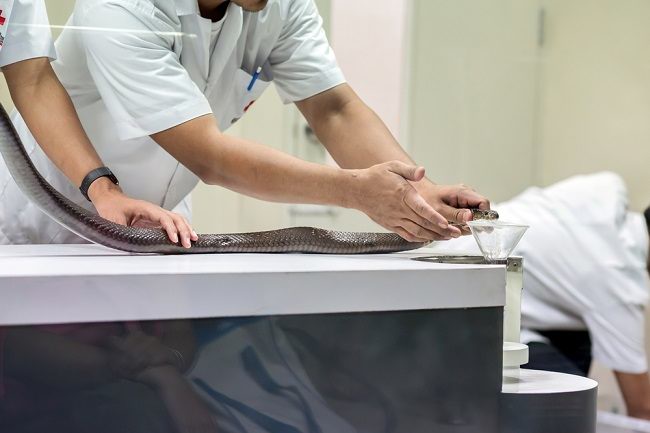Gigantism is growth disturbance that causes children to grow very tall and big, so it looks like a giant. This condition is caused by overproduction of growth hormone.
Gigantism is characterized by a child's body being taller and larger than children his age. This rare condition is usually caused by a benign tumor in the pituitary or pituitary gland.

Gigantism is different from acromegaly. Acromegaly usually occurs in adults and is often diagnosed at the age of 30–50 years, whereas gigantism occurs before the end of puberty or before the growth plates close.
Causes of Gigantism
Gigantism is caused by the production of growth hormone or growth hormone (GH) in excess. Excessive production of this hormone usually occurs due to a tumor in the pituitary gland or pituitary gland.
The pituitary gland is located at the bottom of the brain. This gland plays a role in producing hormones that affect the growth and function of other organs or glands, such as the thyroid gland, adrenal glands, or reproductive organs. The presence of a tumor in the pituitary gland will affect these functions, including affecting the production of growth hormone.
In addition to tumors on the pituitary gland, there are several conditions that can increase the production of growth hormone and eventually trigger gigantism, including:
- carney complex,is a genetic disorder that causes the growth of benign tumors in the skin, endocrine glands, and heart.
- Multiple endocrine neoplasia type 1 (MEN 1), which is a genetic disorder that causes tumors to grow in any of the endocrine glands, including the pituitary, parathyroid, or pancreas.
- McCune-Albright syndrome, which is a genetic disorder that affects bones and pigment (skin color).
- Neurofibromatosis, which is a genetic disorder that causes tumors to grow in the nervous system.
Symptoms of Gigantism
Children with gigantism experience abnormalities in their growth and this abnormality will be seen more clearly as the child ages. Some of the symptoms that can appear are:
- Height and weight above the average for his age
- The size of the hands and feet are very large and thick
- Wide forehead and chin
- Rough face shape
These symptoms will appear before the end of puberty or before the growth plate (Fig.epiphyseal growth plates) closes. In addition to the above symptoms, gigantism can be characterized by several other symptoms, such as:
- Frequent headaches
- Experiencing late puberty
- Having trouble sleeping
- Releasing mother's milk (ASI) prematurely
- Have an irregular menstrual cycle
- Frequent sweating or hyperhidrosis
- Often tired
- Having vision problems
- There is a gap between the teeth
When to go to the doctor
Check with the doctor if your child is experiencing the symptoms of gigantism mentioned above, especially when the child's height and weight are above the average for his age. A doctor's examination needs to be done to find out the cause so that the child can get treatment as soon as possible.
Regular consultation with a doctor is also necessary if you are currently or have recently undergone gigantism treatment. In this condition, the doctor will monitor the progress of the disease and the child's body's response to treatment.
Gigantism Diagnosis
To diagnose gigantism, the doctor will first ask questions about the complaints and medical history of the child and his family. After that, the doctor will perform a physical examination, one of which is anthropometric measurements.
Anthropometry is performed to measure body dimensions consisting of height, weight, body mass index (BMI), body circumference (waist, hips, and other body parts), and thickness of subcutaneous fat. The results of this measurement will be compared with the growth curve.
To confirm the diagnosis, the doctor will perform supporting examinations using the following methods:
- Blood tests, to measure hormone levels in the body, including growth hormone
- Scans with MRI and CT scans, to find the presence of a pituitary tumor and diagnose the cause of excess GH . levels
Gigantism Treatment
Treatment of gigantism aims to stop or slow down the production of growth hormone (GH) in children. Some of the treatment options that doctors can give to treat gigantism are:
Operation
Surgery is performed to remove a pituitary tumor that is pressing on nerves and triggering increased production of growth hormone (GH).
Drugs
Medications may be given as supportive treatment after surgery or if surgery cannot be performed. Some of the types of drugs given are:
- Somatostatin analogues, such as octreotide, lanreotide, and sandeotide, to inhibit the secretion of GH, insulin, and glucagon
- Growth hormone antagonists, such as pegvisomant, to inhibit the performance of GH and reduce the concentration of the hormone IGF-1
- Dopamine-receptor agonist, as bromocriptine and cabergoline, to reduce GH production
Drug dopamine-receptor agonist can be combined with somatostatin analogues to be more effective.
Radiation therapy or radiotherapy
Radiation therapy is generally recommended if GH levels do not return to normal after surgery. This therapy will usually take several months to years to get effective results. One type of radiotherapy that can be done is gamma or -ray therapy gamma knife radiosurgery.
Gigantism Complications
One of the complications that can be experienced by people with gigantism is the recurrence of a pituitary tumor that causes gigantism, even though this tumor has been operated on or treated.
In addition, surgical procedures and radiotherapy performed to treat gigantism can also cause a number of complications, such as:
- Hypogonadism
- Hypothyroidism
- Adrenal insufficiency (lack of adrenal hormones)
- Diabetes insipidus
Prevention of Gigantism
Gigantism cannot be prevented. If you see the symptoms of gigantism in your child, immediately consult a doctor so that he can be treated quickly. If diagnosed and treated early, complaints and symptoms can be quickly resolved before they get worse.









